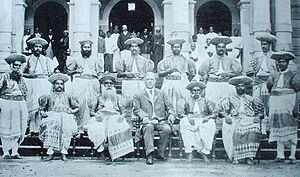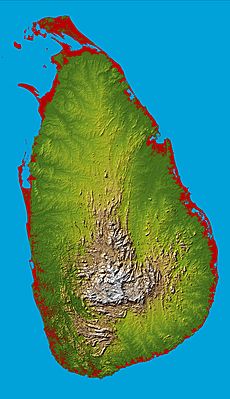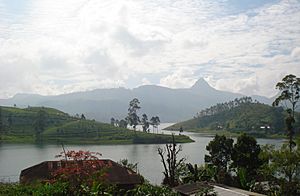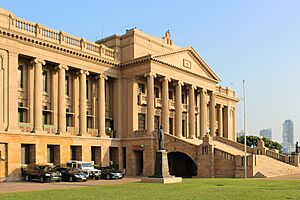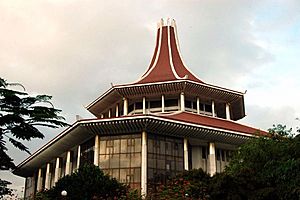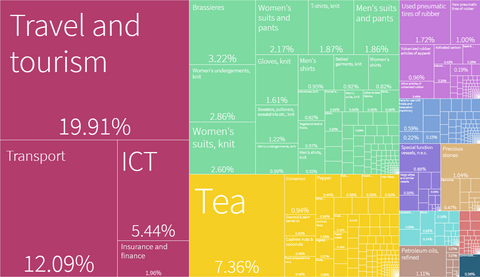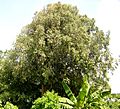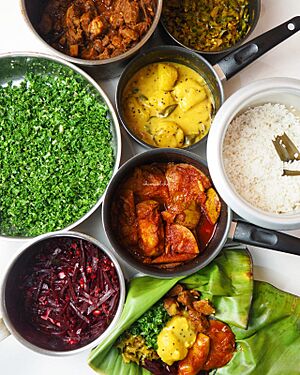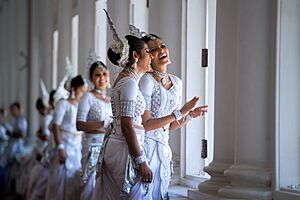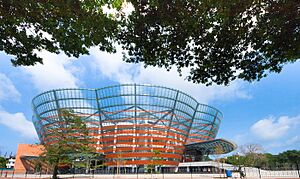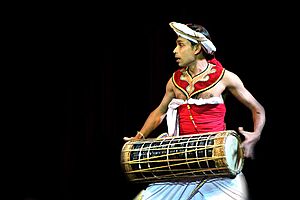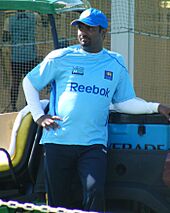Sri Lanka facts for kids
Quick facts for kids
Democratic Socialist Republic of
Sri Lanka |
|
|---|---|
|
|
|
|
Anthem: "Sri Lanka Matha"
ශ්රී ලංකා මාතා (Sinhala) ஸ்ரீ லங்கா தாயே (Tamil) (English: "Mother Sri Lanka") |
|
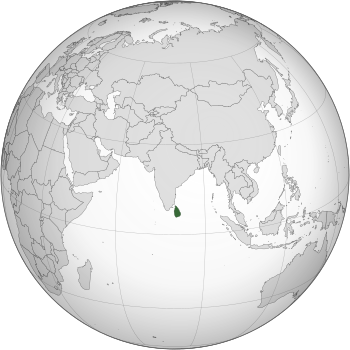 |
|
| Capital |
|
| Largest city | Colombo |
| Official languages | |
| Recognised language | English |
| Ethnic groups
(2012)
|
|
| Religion
(2012)
|
70.2% Buddhism (official) 12.6% Hinduism 9.7% Islam 7.4% Christianity 0.1% other / none |
| Demonym(s) | Sri Lankan |
| Government | Unitary semi-presidential republic |
| Anura Kumara Dissanayake | |
| Harini Amarasuriya | |
|
• Speaker of the Parliament
|
Ashoka Ranwala |
| Legislature | Parliament |
| Formation | |
|
• Kingdom established
|
543 BCE |
|
• Anuradhapura period
|
377 BCE–1017 CE |
|
• Polonnaruwa period
|
1017–1232 |
|
• Transitional period
|
1232–1592 |
|
• Kandyan period
|
1592–1815 |
| 1815–1948 | |
|
• Independence
|
4 February 1948 |
|
• Republic
|
22 May 1972 |
|
• Current constitution
|
7 September 1978 |
| Area | |
|
• Total
|
65,610.2 km2 (25,332.2 sq mi) (120th) |
|
• Water (%)
|
4.4 |
| Population | |
|
• 2022 estimate
|
|
|
• 2012 census
|
20,277,600 |
|
• Density
|
337.7/km2 (874.6/sq mi) (43rd) |
| GDP (PPP) | 2023 estimate |
|
• Total
|
|
|
• Per capita
|
|
| GDP (nominal) | 2023 estimate |
|
• Total
|
|
|
• Per capita
|
|
| Gini (2016) | 39.8 medium |
| HDI (2022) | high · 78th |
| Currency | Sri Lankan rupee (Rs) (LKR) |
| Time zone | UTC+5:30 (SLST) |
| Driving side | left |
| Calling code | +94 |
| ISO 3166 code | LK |
| Internet TLD | |
The Democratic Socialist Republic of Sri Lanka is an island nation located off the southeast coast of India. Its capital city is Sri Jayawardenepura Kotte, and its largest city is Colombo. Before 1972, it was known as Ceylon. Sri Lanka is one of the oldest democracies in Asia.
Contents
History of Sri Lanka
Sri Lanka has a very long and interesting history, going back 3,000 years. People have lived there for at least 125,000 years! The first Buddhist writings in Sri Lanka were created around 29 BCE.
Because of its location, Sri Lanka was an important trading hub. It was known as the Pearl of the Indian Ocean or the Granary of the East. Traders from Asia and Europe visited the island even in ancient times.
Over the centuries, different groups tried to control Sri Lanka. The Portuguese arrived first, followed by the Dutch and then the British. The British took full control in 1815, calling it British Ceylon.
Sri Lanka gained its independence from British rule on February 4, 1948. It became a republic in 1972. Later, the country experienced a civil war from 1983 to 2009. This conflict ended when the Sri Lanka Armed Forces defeated the Liberation Tigers of Tamil Eelam.
Ethnic Groups
Sri Lanka is home to several different ethnic groups. These groups have their own religions and traditions. The total population of the island is over 20 million people.
The largest group is the Sinhalese, who make up about 75% of the population. Most Sinhalese people are Buddhist, and they speak the Sinhala language.
The second largest group is the Tamil people. Most Tamils are Hindu. There are about 2.2 million Tamils in Sri Lanka.
The third largest group is the Sri Lankan Moors, who are Muslim. There are over 1.5 million people in this group. They mostly speak the Tamil language today.
There are also smaller groups, like the Veddas. They are considered to be some of the earliest people to live on the island.
Provinces
Sri Lanka is divided into 9 provinces:
Geography of Sri Lanka
Sri Lanka is an island in South Asia that looks like a teardrop or a mango. It's located in the Indian Ocean, southwest of the Bay of Bengal. The island is separated from India by the Gulf of Mannar and Palk Strait.
Long ago, there might have been a land bridge connecting Sri Lanka to India. Today, only a chain of limestone shoals, called Adam's Bridge, remains above sea level.
Most of Sri Lanka is made up of flat coastal plains. Mountains rise only in the south-central part of the island. The highest point is Pidurutalagala, which is 2,524 meters (8,281 feet) above sea level.
Sri Lanka has 103 rivers. The longest is the Mahaweli River, which is 335 kilometers (208 miles) long. These rivers create 51 natural waterfalls that are 10 meters (33 feet) or taller. The highest waterfall is Bambarakanda Falls, at 263 meters (863 feet) high.
The coastline of Sri Lanka is 1,585 kilometers (985 miles) long. The waters around the island have amazing marine life, including coral reefs and seagrass beds. Sri Lanka also has 45 estuaries and 40 lagoons. Its mangrove forests help protect the coast from strong waves, like those from the 2004 tsunami.
The island is rich in minerals such as graphite and ilmenite. There is also oil and gas found in the Gulf of Mannar.
Climate
Sri Lanka has a tropical climate, which means it's warm all year round. Ocean winds help keep the temperatures mild. In the central mountains, temperatures can be around 17°C (63°F), while in lower areas, they can reach up to 33°C (91°F).
Rainfall is affected by monsoon winds. Some areas, like the "wet zone" and parts of the central highlands, get a lot of rain (up to 2,500 mm or 98 inches per year). Other areas, like the "dry zone" in the east and north, get less rain. Sometimes, tropical cyclones bring heavy rains and cloudy skies.
Flora and Fauna
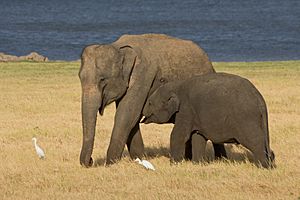
Sri Lanka is a "biodiversity hotspot" because it has so many different kinds of plants and animals, many of which are found nowhere else in the world. For example, 27% of its flowering plants and 22% of its mammals are unique to the island.
The island is home to 453 species of birds, with 240 species known to breed there. About 33 bird species are found only in Sri Lanka.
Sri Lanka has many protected areas, like national parks and nature reserves. About 26.5% of the country's land is protected, which is a higher percentage than most other Asian countries.

You can find different types of forests in Sri Lanka. The dry-land forests have valuable trees like satinwood and teak. The wet zone has tropical evergreen forests with tall trees and thick plants. Higher up in the mountains, you'll find subtropical evergreen forests.
Yala National Park is famous for its elephants, deer, and peacocks. Wilpattu National Park, the largest national park, is a great place to see water birds like storks and pelicans.
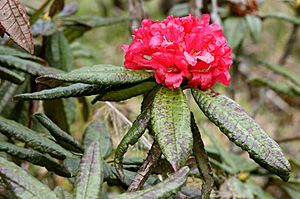
The Sinharaja Forest Reserve is a special rainforest. It's home to 26 bird species and 20 rainforest species that are found only there. Many of its trees are also unique to the reserve.
Unfortunately, Sri Lanka has seen a decrease in its forest cover over the years. In 1956, forests covered 44.2% of the country, but by 2010, it was down to 28.7%.
Government and Politics
Sri Lanka is a democratic republic and a unitary state. This means it's a country where citizens vote for their leaders, and the central government has most of the power. Sri Lanka is the oldest democracy in Asia.
The government has three main parts, just like many other democracies:
- Executive: The President of Sri Lanka is the head of the country and the leader of the armed forces. The president is elected by the people for a five-year term. They lead the cabinet (a group of ministers) and choose ministers from elected members of parliament.
- Legislative: The Parliament of Sri Lanka makes the laws. It has 225 members who are elected by the people for a five-year term. The president can call, pause, or end a parliamentary session. The Prime Minister leads the main political party in parliament.
- Judicial: Sri Lanka's courts include the Supreme Court of Sri Lanka, which is the highest court, a Court of Appeal, High Courts, and other local courts. The legal system uses a mix of British law, Roman-Dutch law, and traditional laws for things like marriage and inheritance. Judges are appointed by the president.
Economy
Sri Lanka's main economic activities include tourism, exporting tea, making clothes, and growing rice and other farm products.
As of 2020, services (like tourism and banking) make up most of the economy (59.7%). Industries (like manufacturing) make up 26.2%, and agriculture (farming) makes up 8.4%. Most of the economy (85%) is run by private businesses. China, India, and the United States are Sri Lanka's biggest trading partners.
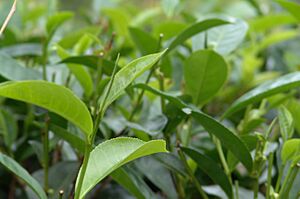
Between 2005 and 2011, the average income per person in Sri Lanka doubled. During this time, the number of people living in poverty dropped from 15.2% to 7.6%. Also, more people have access to electricity (99%) and safe drinking water (93.2%).
Languages
Sinhala and Tamil are the two official languages of Sri Lanka. English is also widely used for education, science, and business.
Some smaller communities, like the Burgher people, speak forms of Portuguese Creole and Dutch. The Malay community speaks a unique form of Creole Malay.
Religion
Buddhism is the most widely practiced religion in Sri Lanka, followed by 70.2% of the population. Sri Lanka has the longest continuous history of Buddhism among countries where Buddhism is the main religion.
Before Buddhism arrived in the 3rd century BCE, Hinduism was the main religion. Buddhism was brought to Sri Lanka by Mahinda, the son of Emperor Ashoka. The Sinhalese people adopted Buddhism, while many Tamils in Sri Lanka remained Hindus.
Islam is the third most common religion in the country. Most Muslims on the island follow the Sunni branch of Islam.
About 7.4% of Sri Lankans are Christians, and most of them are Roman Catholics. There is also a small group of Zoroastrian immigrants from India.
National Symbols of Sri Lanka
Flag
The Sri Lankan flag is also known as the Lion Flag because it features a lion holding a sword. The lion is on a crimson background with four leaves in each corner. There is a yellow border around the main design. On the left side of the flag, there are green and saffron stripes.
The lion represents bravery. The four leaves stand for kindness, friendliness, joy, and calmness. The orange stripe represents the Sri Lankan Tamils, and the green stripe represents the Sri Lankan Moors.
Culture

The culture of Sri Lanka is greatly influenced by Buddhism and Hinduism. Sri Lanka has two main traditional cultures: the Sinhalese culture (found in areas like Kandy) and the Tamil culture (found in areas like Jaffna). These two groups have lived together for a long time.
Ancient Sri Lanka was known for its amazing skills in building water systems and beautiful architecture. British colonial culture has also influenced the local way of life. The rich cultural traditions in Sri Lanka contribute to the country's high life expectancy, good health standards, and high literacy rate.
Food and Festivals
Popular Sri Lankan dishes include rice and curry, pittu, kiribath, and kottu. Sometimes, jackfruit is used instead of rice. Traditionally, food is served on a plantain leaf or lotus leaf. You can also find influences from Middle Eastern, Dutch, and Portuguese cooking in some traditional dishes.
In April, Sri Lankans celebrate the Buddhist and Hindu new year festivals. The Esala Perahera is a famous Buddhist festival held in Kandy in July and August. It features dances and decorated elephants. Christians celebrate Christmas and Easter. Tamils celebrate Thai Pongal and Maha Shivaratri, and Muslims celebrate Hajj and Ramadan.
Arts and Entertainment
Sri Lankan cinema began in 1947 with the movie Kadawunu Poronduwa (The Broken Promise). Later, Ranmuthu Duwa (Island of Treasures) was the first color film. Sri Lankan movies often focus on family stories and social changes.
An important filmmaker is Lester James Peiris, who directed many internationally recognized movies like Rekava (Line of Destiny).
The earliest music in Sri Lanka came from plays. Traditional instruments like the Béra and Răbān were used. Famous musicians like W. D. Amaradeva have greatly contributed to Sri Lankan music. Baila music is a lively style that came from the Afro-Sinhalese community.
There are three main styles of Sri Lankan classical dance: Kandyan, low country, and Sabaragamuwa dances. The Kandyan style is the most well-known. Dancers wear elaborate headdresses, and a drum called Geta Béraya helps them keep rhythm.
Sri Lankan painting and sculpture date back to the 2nd or 3rd century BCE. Ancient writings describe beautiful paintings in Buddhist temples.
Theatre came to Sri Lanka in the 19th century. The "golden age" of Sri Lankan drama began in 1956 with the play Maname.
Sri Lankan literature is very old, going back at least two thousand years. Important ancient works include the Mahāvaṃsa, which tells the stories of Sri Lankan kings. Medieval Sri Lanka saw beautiful poetic messages and prose works. In modern times, authors like Martin Wickramasinghe became very famous.
Sport
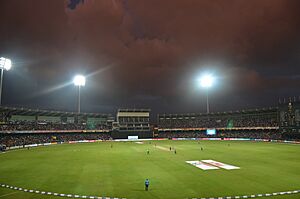
While the national sport is volleyball, Cricket is by far the most popular sport in Sri Lanka. Rugby union, association football (soccer), netball, and tennis are also very popular. Water sports like surfing and scuba diving are enjoyed by many. Sri Lanka also has two native martial arts: Cheena di and Angampora.
The Sri Lanka national cricket team has been very successful. They won the 1996 Cricket World Cup and the 2014 ICC World Twenty20. They were also runners-up in the Cricket World Cup in 2007 and 2011. Muttiah Muralitharan, a famous Sri Lankan bowler, holds the record for the most wickets in Test Cricket. Sri Lanka has also won the Asia Cup several times.
Sri Lankans have won two medals at the Olympic Games: one silver in 1948 by Duncan White for hurdles, and another silver in 2000 by Susanthika Jayasinghe for a sprint event. In billiards, Muhammad Lafir won the World Billiards Championship in 1973. Sri Lanka has also won the Carrom World Championship titles multiple times.
The Sri Lanka national football team won the 1995 South Asian Gold Cup.
Related Pages
Images for kids
-
Ptolemy's world map of Ceylon, first century CE, in a 1535 publication
-
A 17th-century engraving of Dutch explorer Joris van Spilbergen meeting with King Vimaladharmasuriya in 1602
-
A 1595 map of Sri Lanka created by Dutch cartographer Petrus Plancius
-
President J. R. Jayewardene gifting a baby elephant to US President Ronald Reagan in 1984
See also
 In Spanish: Sri Lanka para niños
In Spanish: Sri Lanka para niños




